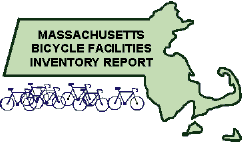
Next: Cross-State Routes
| Top: MassPaths Home Page |
| Up: Table of Contents | |
| Previous: Southeastern Regional | |
Next: Cross-State Routes |
Statewide Prioritization ProcessRationale for prioritizationThe project has been assigned the task of defining priorities for the inventoried bicycle facilities. Certain facilities projects promise to have a larger impact than others, or to be more cost-effective. Additionally, the inventory of all projects proposed for Massachusetts suggests how projects may connect so as to have a greater effect than the sum of their parts. Prioritization was based, to the degree possible, on objective, transportation-based measures, with input from citizens, BCOM, regional planning agencies (RPAs) and the BTP&D. Prioritization Criteria and MethodologyEmphasis on transportationFor the purposes of this project, the emphasis in the prioritization process was on transportation. As an aid to the prioritization process, a numerical matrix was developed, as follows:
Maximum possible score 100 points Adjusting numerical criteriaSome of the criteria for the numerical rating scheme are straightforward. However, other criteria generate some inconsistencies and problems, as follows: Unclear distinctions between existing and proposed facilitiesWith few exceptions, the roads described in this project already exist and are open to bicycle traffic. Such roads fall under the definition of "existing facility." However, an existing road facility suggests more attention to maintenance. The same issue arises in connection with existing bicycle paths to which improvements are proposed. Whenever such issues have arisen, the project is described as "existing." The proposed improvements have been described in "proposed facility" and "project description" fields of the database which accompanies this report. Defining connectivityFor the purposes of this project, connectivity is defined as linkage to roads and other facilities which form a network of bicycle routes. This is the most sensible definition, but the information to describe such a network has not been submitted to the project. For these reasons, project staff has had to rely on additional sources of information to determine connectivity. Primary sources have been the State Bicycle Map of 1986 and other maps, as well as critical evaluation by bicyclists familiar with the roads in various parts of Massachusetts. Effect of motor traffic volumeMost descriptions of traffic volume were anecdotal, based on input from commenters. Also, high traffic volume should count strongly in favor of a project involving physical road improvements such as widening, particularly when an alternate route is not available. However, in the numerical matrix, traffic volume counts against all projects. For this reason, the effect of traffic volume on priority of projects has been evaluated based on the type of project proposed. Dependence of numerical rating of regional quality on description of projectsOne large project achieves a higher rating. To some extent, this problem is offset by considering connectivity; yet project staff has found anomalously high ratings for one particular type of suggestion. This usually takes the form that "all roads in the [insert name] area should be improved with wide shoulders." Had improvements been described separately for roads in each town, their ratings would have been lower. Parking facilities are not adequately recognizedParking facilities fall entirely outside the numerical matrix, which is oriented toward route connections. Parking tends to be a local issue and occurs at widely dispersed locations. Most parking facilities described to the project were recently constructed or proposed for construction in the near future. Combining objective and subjective criteriaProject staff has therefore used the numerical matrix only as a basis for further evaluation. The final determination has been made subjectively. However, each RPA has a few projects which stand out well beyond the others in terms of their potential effect to improve conditions for bicycling. The working evaluation has been based on the same characteristics as the numerical matrix, while correcting for the anomalies. It is less easy to arrive at equitable prioritization for the entire state. This is because the size and population density of the different regions vary greatly, as do the types of bicycle use. The numerical matrix is, however, more useful in comparing similar projects in different regions than it is in comparing projects of different types in the same region.
Input from RPAs, public meetings and the BTP&DThe priority ratings determined by project staff as described in preceding sections were open to review by the RPAs; by the public at a second round of public meetings; and by the BTP&D. It should be noted that any of these may have different priorities for bicycle facilities. This is particularly the case when an RPA is preparing a bicycle transportation plan which is not yet complete. Design guidelines, and state of engineering practiceThe AASHTO (American Association of State Highway and Transportation Engineers) Guide for the Development of Bicycle Facilities (1991) is the standard reference work on bicycle facilities design. The AASHTO guide recommends several types of facilities, and states engineering criteria for them. These include shared roadways, bicycle lanes on roadways, and paths separate from roadways. The FHWA document "Selecting Roadway Design Treatments to Accommodate Bicycles" gives specific design advice tailored to the type of bicycle use expected. Both have been sent to all Massachusetts cities and towns along with the manual "Building Better Bicycling." Citing operational problems, AASHTO discourages construction of paths directly adjacent to roadways. AASHTO also warns that conflicts result from mixing of bicycle and pedestrian traffic, though these problems may be alleviated to some degree by widening a path beyond the allowable minimum of 8 feet. Also, path function varies greatly depending on numerous factors including separation from the parallel road, the number of crossings, and the traffic volume and speed at those crossings. BCOM recognizes that some Massachusetts cities and towns must make design choices in the face of numerous constraints, and that the prioritization procedure was negotiated through the terms of the contract. Project inclusion within this inventory in no way implies an endorsement by the Bicycle Coalition of Massachusetts, the Executive Office of Transportation and Construction or the Massachusetts Highway Department. |